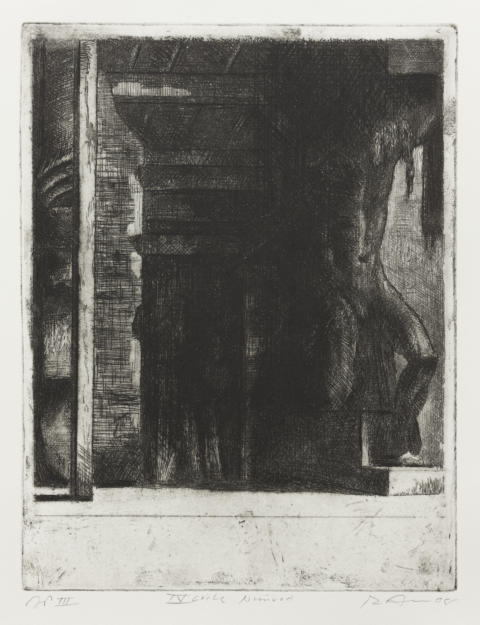
Etching. A naked male figure stands on a step at the right, supporting himself on his proper right knee. His bent head is shrouded in darkness, as though weighed down by the coffered ceiling, from which is suspended a chain that binds him. At the left is a tall and thin square column, and to its right a doorway, in which stands an upright, ambiguous shape. Beneath this scene is a ruled etched line with a blank band below. The image is rendered with close cross-hatching. Foul biting is present.
Drypoint has been added to many areas of the plate, principally in order to better define the architectural features and the giant’s body. Drypoint has also been added to the two shapes in the doorway. The inner left line of the column at left has been prominently strengthened with drypoint, as has the area in darkness at the upper right.
More burnishing has been applied to areas on the left of the column at left. There are four variant impressions of this state.
Several drypoint strokes have been added to the upper section of the curved architectural detail at the upper left, to tone down its highlight; irregular drypoint scratches have been added intermittently to the strip of wall immediately to the left of the door. There are four variant impressions of this state.
- Catalogue Number
- E.152
- Title and Date
- IX Circle (Nimrod) 2008
- Description of Featured Image
- A naked male figure stands on a step at the right, supporting himself on his proper right knee. His bent head is shrouded in darkness, weighed down by the coffered ceiling, from which is suspended a chain that binds him. At the left is a tall and thin square column, and to its right, in the centre, a doorway in which stands an upright, ambiguous shape.
- Where Made
- Alphington, Melbourne
- Medium Category and Technique
- Intaglio Print: Etching, foul biting, burnishing and drypoint on copper
- Support
- Wove paper. Identified papers: BFK Rives paper with watermark: ‘BFK RIVES / FRANCE’ with infinity symbol; Hahnemühle paper with watermark: cockerel within a circle; Velin Arches paper.
- Dimensions
-
Image size: 298 x 227 mm
Matrix size: 300 x 230 mm - Artist’s Record Number
- RAE.179
- Printer(s) and Workshop(s)
- All state impressions printed by Rick Amor in his Alphington studio. Edition printed by Rosalind Atkins at the Australian Print Workshop, Fitzroy (Melbourne).
- Summary Edition Information
- Six states. Edition of ten numbered impressions, 2008.
- Literature
- For an illustration of the painting The IXth Circle (and Nimrod), 2007, see Niagara Galleries, Rick Amor 2008 (exh. cat.), Niagara Galleries, Richmond, Victoria, 2008, cat. no. 7.
- Collections
- State Library of Victoria, Melbourne: five state impressions, numbered 1-1 through 1-5; bon à tirer impression; ed. 2/10.
- Comment
This etching is based on an oil with a similar title, painted in 2007 and exhibited in the following year at Niagara Galleries (Niagara Galleries 2008). The print, in turn, became the model for a small painting (subsequently destroyed by the artist). The figure of the giant Nimrod is based on a three metre sculpture in concrete, made in 1992 by Amor’s friend the sculptor Peter Corlett (b. 1944); titled Mondo, it is one of four works by Corlett located at the corner of Queen and Franklin Streets in Melbourne’s CBD.
Nimrod – who supposedly built the Tower of Babel – is one of three giants inhabiting the penultimate circle of Dante’s Inferno: the circle of traitors, who are described in Canto XXXI as standing waist-deep in a pit. Nimrod is a figure of colossal proportions – ‘His visage seem’d / In length and bulk, as doth the pine, that tops / Saint Peter’s Roman fane; and th’other bones / Of like proportion’ (XXXI, 52–55; transl. Cary 1814).
Amor’s etching does not follow Dante’s account literally. Instead, Amor evokes the general atmosphere of darkness in the narrative – a darkness so intense that it could deceive the senses (XXXI, 19–24). For the belt around the neck of the giant, he has substituted a chain.
Amor has been familiar with Dante’s Divine Comedy since childhood, his father having owned a copy of an edition of the Henry Cary translation (1814), with illustrations by Gustave Doré; Amor still has this volume. Like many artists before him, he has been especially drawn to the Inferno and he has read the text in several translations. During the 1970s, responding to the surreal aspect of Dante’s imagination, he painted subjects from the book, using John Ciardi’s translation of the Inferno (1954), but later destroyed these works. More recently, he has greatly admired Clive James’s translation of the Divine Comedy (2013).
- Keywords
- Dante, Nimrod, Nude - male, Peter Corlett, Statue
- URL
- https://catalogue.rickamor.com.au/works/intaglio/ix-circle-nimrod/
Record last updated 17/02/2021








